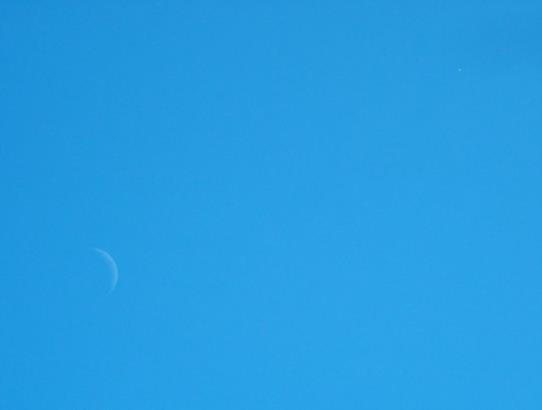
NavList:
A Community Devoted to the Preservation and Practice of Celestial Navigation and Other Methods of Traditional Wayfinding
From: Frank Reed
Date: 2010 Sep 12, 13:36 -0700
George Huxtable, you wrote:
"The fact that Venus showed clearly on 38 out of 40 shots shows that it's
sgnificantly above some signal to backgrond detectability threshold. But
the fact that it failed to do so on 2 out of 40 shows that it wasn't very
far above that threshold, and there isn't a lot in hand to play with."
I should have been more clear. One of the two was blurred by hand motion. The other was well out-of-focus. As I mentioned, this camera does not autofocus properly on an empty blue sky. In the other images, Venus was obvious. And I do mean OBVIOUS. No image processing or analysis is required to see it. I've decided to attach one of the photos. This was taken around 3:50 in the afternoon EDT (UT-4) on Sep 11, 2010 from Groton, Connecticut.
You wrote:
"Now consider magnitudes. Venus on that day was about as bright as it gets,
magnitude -4.5. Frank wants to get down to stars of magnitude +1.5. The
difference is six orders of magnitude."
It's six *magnitudes*, yes, but it may be a little unwise to use the expression "orders of magnitudes" which probably should be reserved for factors of ten (or so). You're quite right, though, that this is a stretch. Every five magnitudes is a factor of 100 in brightness. Six magnitudes is a factor of 100^(6/5) in brightness, or about 250. I doubt that we could go much deeper than mag. 1.5 with off-the-shelf technology, and we might not even get to magnitude 1.0. We won't know without some experimentation.
You concluded:
"it's hard to see how that is to be overcome by technology.
A touch of realism is called for."
Whoa there. You DO RECALL, I hope, that I said that these photos were taken with an old, non-SLR camera (I believe I bought it in 2003; I might have said 2002 before). It's better than a "snapshot" camera, but not much better. It has no manual focus, minimal ISO range, no raw file output, and no ability to be controlled by software. The question is still wide open: how low can you go? The evidence I have presented is a simple demo. It is by no means the end of the story.
-FER
----------------------------------------------------------------
NavList message boards and member settings: www.fer3.com/NavList
Members may optionally receive posts by email.
To cancel email delivery, send a message to NoMail[at]fer3.com
----------------------------------------------------------------







